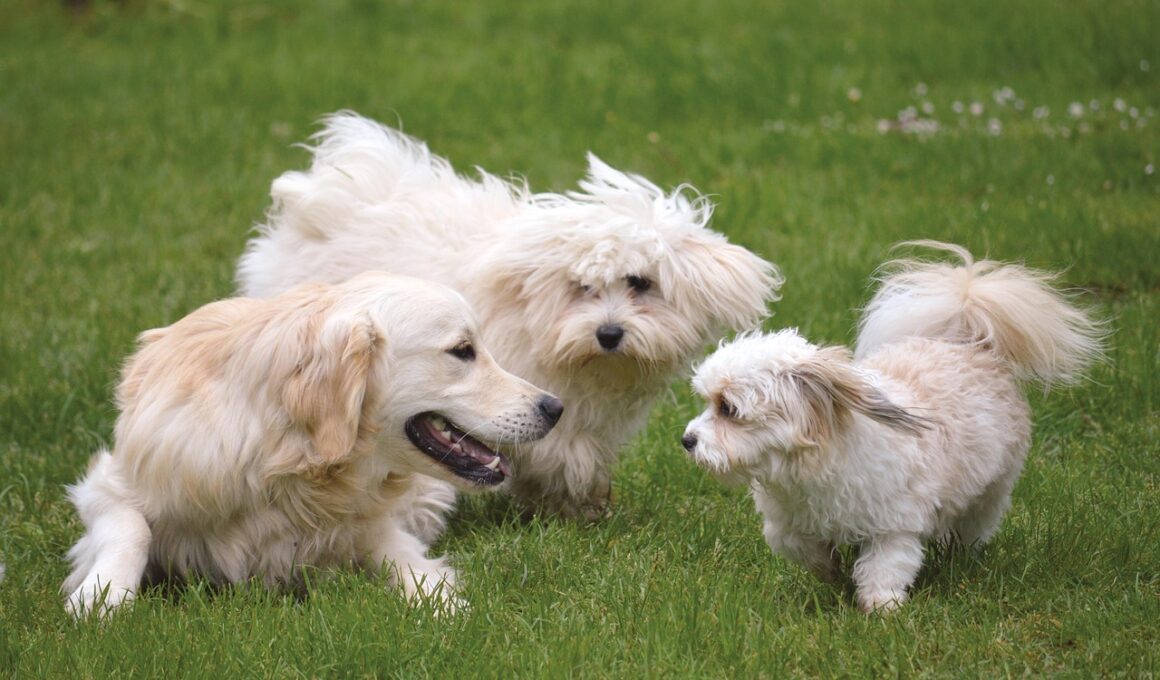How Lack of Gradual Exposure Hampers Dog Socialization
When it comes to dog socialization, a significant mistake many owners make is neglecting gradual exposure. Gradual exposure is crucial because it allows dogs to acclimate to various environments, people, and other pets. Jumping headfirst into crowded spaces can overwhelm a dog. Indeed, anxiety often arises from rapid transitions. Therefore, it’s vital to take small steps to ensure each new experience is manageable. Deciding to expose a dog to a packed park on the first outing without prior preparation can yield negative consequences. It may foster fear or aggression in some instances. Gradual exposure not only builds confidence but also enhances a dog’s comfort level in new situations. Observing how a dog reacts helps in tailoring future interactions. Forcing a dog into unfamiliar territory too quickly can lead to stress. Utilizing a leash and guiding the dog slowly through controlled environments can help. This method reinforces positive behaviors while encouraging the dog to explore its surroundings comfortably. Owners can also include treats and favorite toys for added motivation and reassurance. Thus, gradual exposure is paramount for effective dog socialization.
Another common socialization mistake is overlooking the importance of positive reinforcement during gradual exposure. While the gradual approach is essential, it should be accompanied by encouragement and rewards. When a dog successfully navigates a new experience, offering praise or treats can significantly boost their confidence. Positive reinforcement helps to create a favorable association with the experience, ensuring that the dog feels safe and happy. It is not just about minimizing fear; it’s also about promoting curiosity. Additionally, exposing them to various stimuli while rewarding good behavior reinforces desired responses. For example, during walks in busy areas, rewarding calm behavior can condition a dog to respond positively. Depriving a dog of rewards can lead to confusion and hesitation. Furthermore, incorporating socialization into everyday routines also yields benefits, such as meeting other dogs or encountering people regularly. This exposure, paired with positive experiences, can lead to a well-adjusted canine companion. Ultimately, recognizing the power of rewards can make a tremendous difference in the effectiveness of gradual exposure methods. By combining these elements, owners can foster an environment conducive to optimal socialization.
The role of exposure duration in socialization cannot be emphasized enough. A common oversight is failing to monitor the duration of exposure to new environments. A brief exposure may yield varied results for different dogs. Some may adapt quickly, while others require extended periods to feel comfortable. Owners often mistakenly think that a quick introduction is sufficient, neglecting the unique needs of their dogs. Monitoring signs of stress is essential; if a dog appears uncomfortable, it may be beneficial to shorten the exposure time initially. Gradually increasing exposure duration allows the dog to process new stimuli without feeling overwhelmed. Forcing prolonged exposure can result in detrimental effects, like anxiety or fear-based behavior. Moreover, taking the time necessary for each dog’s comfort level ensures a positive learning experience. This process often involves returning to settings multiple times to allow for in-depth acclimatization. As the dog grows more comfortable, the duration of exposure can be increased systematically. Ultimately, understanding how time influences acclimatization is important in fostering successful social experiences. Each dog’s needs should drive the approach taken during socialization.
The Importance of Controlled Socialization
Controlled environments play a key role in effective dog socialization. During initial outings, owners typically fail to realize that uncontrolled settings can lead to miscommunication or anxiety. An uncontrolled environment may expose the dog to overwhelming stimuli, making it difficult for the dog to focus. When socializing dogs, it’s beneficial to choose quiet parks or controlled groups with minimal distractions. This controlled arena allows for better individual attention and improved engagement levels. Providing a safe space means that the dog can acclimate at its own speed while influencers remain present but unobtrusive. Controlled elements mean that socialization can occur gradually with short interactions increasing in intensity over time. As this progresses, the dog’s comfort level improves significantly. This strategy ensures that exposure promotes confidence instead of fear. Furthermore, monitoring interactions with other dogs is essential in a controlled setting. Owners should observe body language to understand when to intervene; however, allowing safe play is beneficial too. Ultimately, these controlled experiences establish deeper trust in the owner’s guidance, enhancing future adventures.
Failure to recognize individual temperament can also impede proper socialization. Each dog possesses its own personality. For instance, some dogs are naturally extroverted, while others are more introverted or even timid. Overriding their natural inclinations can lead to negative experiences during socialization. It’s essential for owners to identify their dog’s temperament when planning socializing experiences. Understanding what overwhelms or excites your dog can assist in crafting ideal situations for introduction. For fearful or anxious dogs, a slow and steady approach is often necessary. On the other hand, more confident dogs might thrive in energetic, stimulating environments sooner than others. Observing how your dog reacts to various experiences can help demonstrate what works best. Owners should adapt their approach based on these observations, creating personalized socialization plans. This observation-based strategy encourages more successful interactions while affirming the bond between dog and owner. Thus, recognizing the importance of individual temperaments can significantly shape the socializing journeys. Ultimately, customization to fit a dog’s needs can prevent common mistakes that hinder socialization efforts.
The Dangers of Inconsistent Exposures
A significant pitfall in dog socialization is inconsistency. Some owners might be diligent about socializing their dogs initially but then neglect it over time. This inconsistency breeds confusion and insecurity in dogs. Inconsistently exposing dogs to various environments can lead to regressive behavior and fear. For instance, if a dog encounters various locations with both positive and negative outcomes, it may learn to associate certain locations with anxiety. Over time, dogs may become wary of new situations if previous experiences were unpredictable. Consequently, they may act out when encountering unfamiliar people or animals due to improperly managed experiences. Structuring routine socialization practices can help prevent confusion. Making outings a regular habit creates familiarity and comfort for the dog. Engaging constantly with different stimuli ensures ongoing learning opportunities. It’s vital for owners to remain proactive regarding their dog’s social needs. As dogs encounter varied experiences frequently, their ability to process new environments also increases. By maintaining consistent social encounters, owners can improve their dog’s adaptability and confidence over time.
The significance of proper timing in socialization must not be ignored. Many owners attempt to socialize older dogs without addressing their initial experiences. Socialization is most effective during a dog’s early development stages, particularly within the first few months. Waiting too long can lead to a more challenging socialization process. Puppies are particularly adaptable; hence starting socialization early offers incredible benefits. However, waiting until later stages can sow seeds of anxiety and fear, leading some dogs to develop behavioral problems. This timing issue can often be overlooked by first-time dog owners. Instead of waiting for the perfect opportunity, it is essential to prioritize early and consistent socialization efforts. Additionally, controlling when and how to expose the dog to new environments can shape their views positively. Paying attention to natural canine habits and ensuring experiences align with these tendencies is vital. New experiences should reflect gradual introductions and positive conditions. Ultimately, the significance of timely exposure cannot be emphasized enough when pursuing successful dog socialization.
By recognizing and addressing these common socialization mistakes, dog owners have the opportunity to create positive, successful interactions for their pets. Choosing gradual exposure, being consistent, and utilizing positive reinforcement are key elements to rich social experiences. Furthermore, understanding individual temperaments and establishing a controlled socialization environment can significantly enhance this process. It is also essential to provide timely socialization opportunities when dogs are most impressionable. These collective strategies promote confidence and reduce anxiety, ultimately leading to well-socialized dogs. With careful attention and dedication, owners can prevent negative experiences that hinder the social development of their furry companions. Engaging in the dog’s social experiences not only strengthens the bond between dog and owner but also fosters a happy and obedient pet. The journey of socialization is continuous, requiring persistent effort and patience but ultimately yielding tremendous rewards. Thus, learning from previous missteps and gradually applying these principles will facilitate a positive social environment, equipping dogs with tools they need to thrive. By committing to the process, dog owners can nurture confident, well-adjusted dogs who flourish in various situations.


